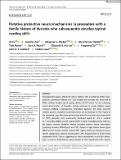| dc.contributor.author | Yu, Xi | |
| dc.contributor.author | Zuk, Jennifer | |
| dc.contributor.author | Perdue, Meaghan V. | |
| dc.contributor.author | Ozernov-Palchik, Ola | |
| dc.contributor.author | Raney, Talia | |
| dc.contributor.author | Beach, Sara Dawley | |
| dc.contributor.author | Norton, Elizabeth S. | |
| dc.contributor.author | Ou, Yangming | |
| dc.contributor.author | Gabrieli, John D. E. | |
| dc.contributor.author | Gaab, Nadine | |
| dc.date.accessioned | 2022-03-29T14:31:03Z | |
| dc.date.available | 2021-04-09T20:17:18Z | |
| dc.date.available | 2022-03-29T14:31:03Z | |
| dc.date.issued | 2020-03 | |
| dc.date.submitted | 2020-01 | |
| dc.identifier.issn | 1065-9471 | |
| dc.identifier.issn | 1097-0193 | |
| dc.identifier.uri | https://hdl.handle.net/1721.1/130434.2 | |
| dc.description.abstract | Human Brain Mapping published by Wiley Periodicals, Inc. Developmental dyslexia affects 40–60% of children with a familial risk (FHD+) compared to a general prevalence of 5–10%. Despite the increased risk, about half of FHD+ children develop typical reading abilities (FHD+Typical). Yet the underlying neural characteristics of favorable reading outcomes in at-risk children remain unknown. Utilizing a retrospective, longitudinal approach, this study examined whether putative protective neural mechanisms can be observed in FHD+Typical at the prereading stage. Functional and structural brain characteristics were examined in 47 FHD+ prereaders who subsequently developed typical (n = 35) or impaired (n = 12) reading abilities and 34 controls (FHD−Typical). Searchlight-based multivariate pattern analyses identified distinct activation patterns during phonological processing between FHD+Typical and FHD−Typical in right inferior frontal gyrus (RIFG) and left temporo-parietal cortex (LTPC) regions. Follow-up analyses on group-specific classification patterns demonstrated LTPC hypoactivation in FHD+Typical compared to FHD−Typical, suggesting this neural characteristic as an FHD+ phenotype. In contrast, RIFG showed hyperactivation in FHD+Typical than FHD−Typical, and its activation pattern was positively correlated with subsequent reading abilities in FHD+ but not controls (FHD−Typical). RIFG hyperactivation in FHD+Typical was further associated with increased interhemispheric functional and structural connectivity. These results suggest that some protective neural mechanisms are already established in FHD+Typical prereaders supporting their typical reading development. | en_US |
| dc.description.sponsorship | National Institute of Child Health and Human Development (Awards R01HD067312 and R01HD65762‐01) | en_US |
| dc.language.iso | en | |
| dc.publisher | Wiley | en_US |
| dc.relation.isversionof | http://dx.doi.org/10.1002/hbm.24980 | en_US |
| dc.rights | Creative Commons Attribution-NonCommercial-NoDerivs License | en_US |
| dc.rights.uri | http://creativecommons.org/licenses/by-nc-nd/4.0/ | en_US |
| dc.source | Wiley | en_US |
| dc.title | Putative protective neural mechanisms in prereaders with a family history of dyslexia who subsequently develop typical reading skills | en_US |
| dc.type | Article | en_US |
| dc.identifier.citation | Yu, Xi et al. "Putative protective neural mechanisms in prereaders with a family history of dyslexia who subsequently develop typical reading skills." Human Brain Mapping 41, 10 (March 2020): 2827-2845 © 2020 The Authors | en_US |
| dc.contributor.department | McGovern Institute for Brain Research at MIT | en_US |
| dc.relation.journal | Human Brain Mapping | en_US |
| dc.eprint.version | Final published version | en_US |
| dc.type.uri | http://purl.org/eprint/type/JournalArticle | en_US |
| eprint.status | http://purl.org/eprint/status/PeerReviewed | en_US |
| dc.date.updated | 2021-03-19T14:40:40Z | |
| dspace.orderedauthors | Yu, X; Zuk, J; Perdue, MV; Ozernov‐Palchik, O; Raney, T; Beach, SD; Norton, ES; Ou, Y; Gabrieli, JDE; Gaab, N | en_US |
| dspace.date.submission | 2021-03-19T14:40:41Z | |
| mit.journal.volume | 41 | en_US |
| mit.journal.issue | 10 | en_US |
| mit.license | PUBLISHER_CC | |
| mit.metadata.status | Authority Work Needed | en_US |
